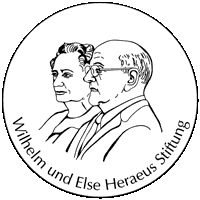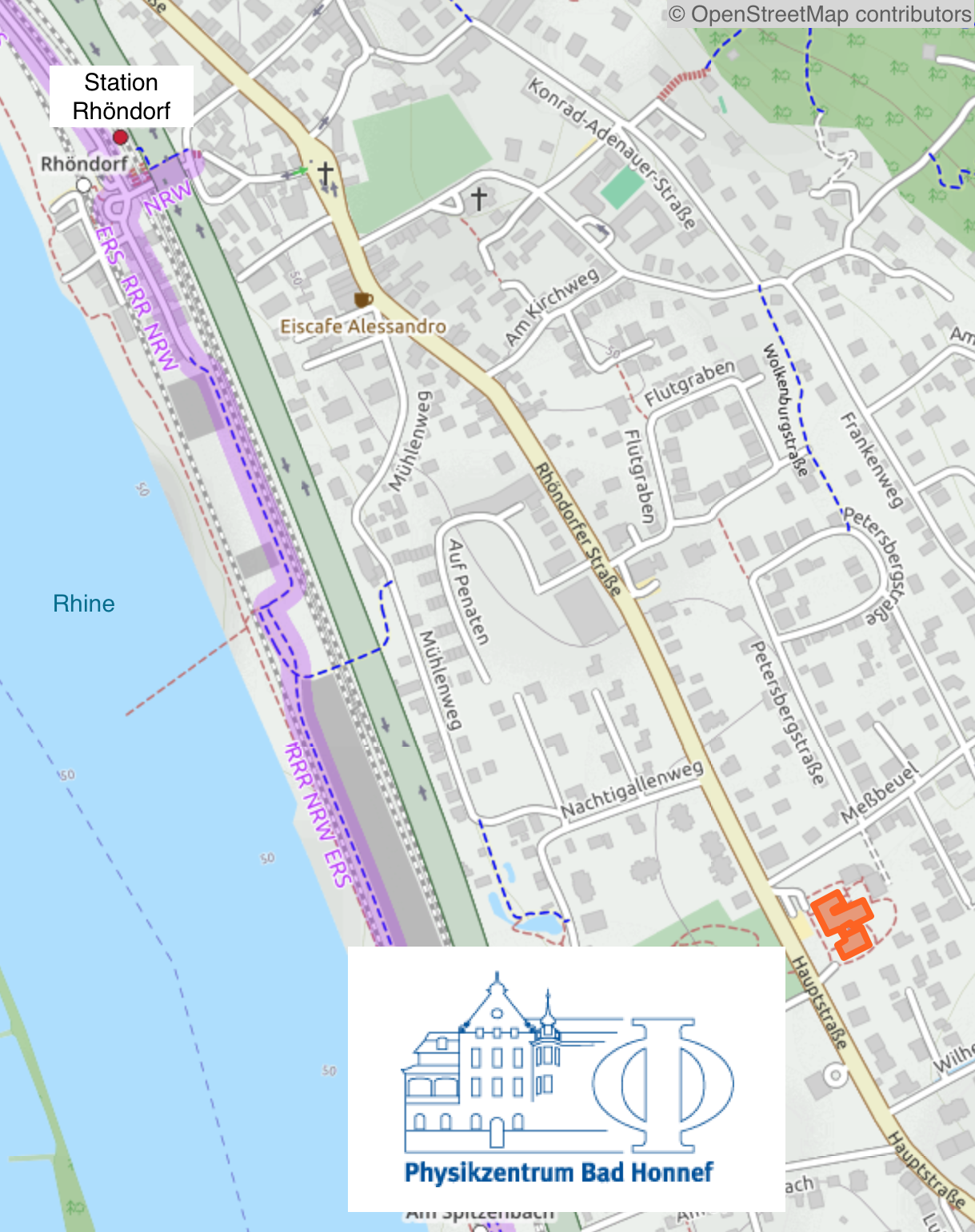660. Wilhelm und Else Heraeus-Seminar
Supernovae - From Simulations to Observations and Nucleosynthetic Fingerprints
 January 21-24, 2018
January 21-24, 2018
Physikzentrum Bad Honnef, Germany
Application deadline: September 30, 2017
SOC: Dr. Anders Jerkstrand (MPA Garching), Dr. Markus Kromer (ZAH/HITS), Dr. Bernhard Müller (QUB)
Generously funded by the Wilhelm und Else Heraeus Stiftung.
Scientific Rationale
Observations and theoretical models have made impressive progress in understanding supernova explosions from massive stars and white dwarfs thanks to the advent of huge transient surveys and advances in high-performance computing. To consolidate progress, it is important to make specialists in different aspects of supernova research aware of progress and challenges on other fronts. This Wilhelm und Else Heraeus Seminar "Supernovae - From Simulations to Observations and Nucleosynthetic Fingerprints", to be held at Physikzentrum Bad Honnef from January 21 to 24, 2018 will bring together world-leading experts, early career researchers, and students to discuss the physical modelling of stellar explosions, their nucleosynthesis, radiation transfer, and supernova observations to further our understanding of these dramatic events that are crucial for the chemical enrichment of the Universe. We aim for a total of about 60 participants (13 invited speakers, 20 contributed-talk speakers, and 30 poster presenters).
Program
Participants will arrive to the Physikzentrum Bad Honnef during the afternoon of January 21. Registration will start during the late afternoon and will be followed by a kick-off meeting on Sunday evening. Monday and Tuesday will be filled with talks and poster viewings. On Wednesday, the seminar will finish after lunch. A detailed schedule will be posted here after the application period has closed.
Key science topics
- What are the explosion mechanisms of SNe? Which CCSNe are neutrino-driven, and for which ones do we need some kind of magneto-rotational mechanism? How are black holes formed and what is the SN-GRB connection? Are thermonuclear explosions dominated by deflagration or detonation burning? Do they explode near or below the Chandrasekhar-mass limit of CO WDs? 3D effects are critical to make progress on these questions, and the workshop will have a strong focus on the latest 3D models.
- What nucleosynthesis do SNe produce? SNe are believed to be the main factories of all heavy elements in the Universe, but little quantitative results yet exist on this process. How well do we understand the origin of different elements, from comparison of nucleosynthesis models and spectral analysis? What does the production of different elements tell us about the progenitor and explosion properties?
- What do current models for light curves and spectra of SNe tell us? The critical link between explosion models and observations is the radiative transfer modelling of light curves and spectra. What properties can we robustly infer with modern codes, and what properties are still difficult to pin down due to limitations in the physical modelling? How do these limitations affect our search for the progenitors of SNe? Can we constrain the most fundamental parameter of the progenitors: the mass of the exploding star?
- What new observational data are needed to make the next breakthroughs? It is at the interface between forefront theory and observations that progress is made. What are the current theoretical predictions that are most valuable to test observationally, in particular in the context of the 'zoo' of transients discovered in the past decade?
Confirmed speakers
- Almudena Arcones (TU Darmstadt)
- Sergei Blinnikov (ITEP Moscow)
- Claes Fransson (Stockholm University)
- John Hillier (University of Pittsburgh)
- Thomas Janka (MPA Garching)
- Kate Maguire (Queen's University Belfast)
- Paolo Mazzali (Liverpool John Moores University)
- Maryam Modjaz (New York University)
- Martin Obergaulinger (University of Valencia)
- Friedrich Röpke (HITS Heidelberg)
- Ivo Seitenzahl (University of New South Wales, Canberra)
- Jesper Sollerman (Stockholm University)
- Claudia Travaglio (INAF Turin)
Contributions
PDF schedule for download.
Talks
Sunday, January 21
- 20:00-21:00 Opening and Welcome (Scientific Organizers)
Monday, January 22
- 08:45-09:30 Simulations of thermonuclear explosions in white dwarf stars (Friedrich Röpke)
- 09:30-09:45 Understanding Type Ia supernova explosion mechanisms by its nucleosynthesis yield (Shing-Chi Leung)
- 09:45-10:00 Abundance tomography of Type Iax SNe (Barnabás Barna)
- 10:45-11:30 3D core-collapse supernova modeling and applications to Cas A and other supernova remnants (Hans-Thomas Janka)
- 11:30-11:45 Opacities and rotation in the revival of the fittest (David Vartanyan)
- 11:45-12:00 Core collapse of massive stars (11.2- 70Msun) and black-hole formation with 3DGR spectral neutrino transport (Takami Kuroda)
- 12:00-12:15 How to form a millisecond magnetar? Magnetic field amplification in a protoneutron star (Jérôme Guilet)
- 12:15-12:30 Young supernova remnants in long-time, 3D supernova simulations (Michael Gabler)
- 14:00-14:45 Core collapse with rotation and magnetic fields (Martin Obergaulinger)
- 14:45-15:30 Poster Flash Presentations
- 16:00-16:45 Nucleosynthetic fingerprints of thermonuclear supernova models (Ivo Seitenzahl)
- 16:45-17:30 Multi-d core collapse supernovae and nucleosynthesis (Claudia Travaglio)
Tuesday, January 23
- 08:45-09:30 Nucleosynthesis in CCSNe (Almudena Arcones)
- 09:30-09:45 Lessons on supernova nucleosynthesis from multi- dimensional models (William Raphael Hix)
- 09:45-10:00 CCSN nucleosynthesis yields across the mass range (Carla Fröhlich)
- 10:00-10:15 Nucleosynthesis in the first supernovae (Alexander Heger)
- 10:45-11:00 Gamma-ray measurements from supernovae and their radioactive afterglows (Roland Diehl)
- 11:00-11:45 Supernova spectral modelling (Paolo Mazzali)
- 11:45-12:00 The physical width-luminosity relation(s) for Type Ia supernovae favour sub-Chandrasekhar and collision models (Nahliel Wygoda)
- 12:00-12:15 Polarization as a test for multi- dimensional explosion models of Type Ia supernovae (Mattia Bulla)
- 12:15-12:30 Recombination Effects on Supernova Light-Curves (Tamar Faran)
- 14:00-14:45 Central Engines of superluminous supernovae and their environment (Sergei Blinnikov)
- 14:45-15:30 Poster Flash Presentations
- 16:00-16:45 Spectral synthesis modelling with CMFGEN (D. John Hillier)
- 16:45-17:00 Supernovae from 8-12 solar mass stars : Multicolor light curve simulations (Alexey Tolstov)
- 17:00-17:15 Modelling the spectral evolution of supernovae (Mattias Ergon)
- 17:15-17:30 The variety of pair-instability supernovae (Alexandra Kozyreva)
Wednesday, January 24
- 08:45-09:30 Observational constraints on the explosion mechanisms of Type Ia supernovae (Kate Maguire)
- 09:30-10:15 The spectroscopic connection between superluminous SNe and SN-GRBs (Maryam Modjaz)
- 10:45-11:00 Supernova physics from spectrophotometric data (Jakob Nordin)
- 11:00-11:15 Multi-band observations of the closest Type I superluminious supernova 2017egm/Gaia17biu in a "normal" metal rich spiral galaxy (Subhash Bose)
- 11:15-12:00 ZTF and supernovae from PTF (Jesper Sollerman)
- 13:30-14:00 Summary talk (Claes Fransson)
Posters
- Mass Transfer in White Dwarf-Neutron Star Binaries (Alexey Bobrick)
- Evidence of Asymmetric CSM in Nearby Ibn SN2015G (Emma Callis)
- Investigating Type Ia Supernova progenitors using spectropolarimetry (Aleksandar Cikota)
- Limits on stable iron in Type Ia SNe from late-time IR spectroscopy (Andreas Flörs)
- New insights on the development of asymmetries durifng the collapse of a rotating star (Thierry Foglizzo)
- Modelling of Low-Mass Core-Collapse Supernovae Spectra and Lightcurves (Dan Gay)
- Chandrasekhar Mass Deflagrations as a Model for Type Iax Supernovae (Florian Lach)
- Early UV emission from disk-originated matter (DOM) in type Ia supernovae in the double degenerate scenario (Naveh Levanon)
- The environments of supernovae Iax: progentior constraints from coeval stellar populations (Joe Lyman)
- Modelling the early time behaviour of type Ia supernovae: effects of the 56Ni distribution (Mark Magee)
- Early and late-time light curve modelling of stripped-envelope supernovae (Andrea Nagy)
- Some problems in spectral modeling of pulsational pair instability SN 2006gy (Marat Potashov)
- Double-peaked SN light curves may be explained by luminosity suppression in standard polytropic envelopes (Nir Sapir)
- Influence of binary mass-transfer on pre-supernova stellar structures (Fabian Schneider)
- Radiative transfer of SNe Ia in the nebular phase (Luke Shingles)
- Zinc in the Sculptor dwarf spheroidal galaxy (Asa Skuladottir)
- 3D Simulations of Low-Mass Core-Collapse Supernovae: Connecting Shock-Revival and Remnant Phase (Georg Stockinger)
- A Comprehensive Analysis of Spitzer Supernovae (Tamas Szalai)
- Insights from late-time observations of SN 2012dn (Stefan Taubenberger)
- Violent Convection in the Oxygen Burning Shell of an 18.8 Msun star: the last 7 minutes prior to collapse in 3D (Nadeen Yadav)
Participants

- Almudena Arcones (TU Darmstadt)
- Barnabás Barna (University of Szeged)
- Sergei Blinnikov (ITEP Moscow)
- Erica Bloor (Florida State)
- Alexey Bobrick (Lund Observatory)
- Subhash Bose (Kavli Peking)
- Mattia Bulla (Stockholm University)
- Emma Callis (UC Dublin)
- Ting-Wan Chen (MPE Garching))
- Aleksandar Cikota (ESO Garching)
- Peter Clark (Queen's University Belfast)
- Mariangelly Díaz-Rodríguez (Florida State)
- Roland Diehl (MPE Garching)
- Mattias Ergon (Stockholm University)
- Tamar Faran (The Hebrew University of Jerusalem)
- Andreas Flörs (ESO Garching)
- Thierry Foglizzo (AIM CEA-Saclay)
- Claes Fransson (Stockholm University)
- Carla Fröhlich (North Carolina State University)
- Michael Gabler (MPA Garching)
- Dan Gay (Queen's University Belfast)
- Jerome Guilet (CEA Saclay)
- Alexander Heger (Monash University)
- John Hillier (University of Pittsburgh)
- W. Raphael Hix (UTK/ORNL)
- Thomas Janka (MPA Garching)
- Anders Jerkstrand (MPA Garching)
- Rubina Kotak (Tuorla Observatory)
- Alexandra Kozyreva (Tel Aviv University)
- Markus Kromer (Heidelberg University)
- Takami Kuroda (TU Darmstadt)
- Florian Lach (HITS Heidelberg)
- Norbert Langer (Bonn University)
- Shing-Chi Leung (IPMU Tokyo)
- Naveh Levanon (Technion, Haifa)
- Joe Lyman (University of Warwick)
- Mark Magee (Queen's University Belfast)
- Kate Maguire (Queen's University Belfast)
- Paolo Mazzali (Liverpool John Moores University)
- Maryam Modjaz (New York University)
- Bernhard Müller (Monash University)
- Andrea Nagy (University of Szeged)
- Jakob Nordin (HU Berlin)
- Martin Obergaulinger (University of Valencia)
- Marat Potashov (ITEP Moscow)
- Friedrich Röpke (HITS Heidelberg)
- Nir Sapir (Soreq, NRC Israel)
- Fabian Schneider (Oxford University)
- Ivo Seitenzahl (University of New South Wales, Canberra)
- Luke Shingles (Queen's University Belfast)
- Avinash Singh (Indian Institute of Astrophysics)
- Asa Skuladottir (MPIA Heidelberg)
- Jesper Sollerman (Stockholm University)
- Georg Stockinger (MPA Garching)
- Tamas Szalai (University of Szeged)
- Stefan Taubenberger (ESO/MPA Garching)
- Alexey Tolstov (Kavli IMPU)
- Claudia Travaglio (INAF Turin)
- David Vartanyan (Princeton University)
- Christian Vogl (MPA Garching)
- Nahliel Wygoda (Weizmann Institute)
- Naveen Yadav (MPA Garching)
Venue
 The seminar will be held at the Physikzentrum Bad Honnef (Hauptstrasse 5, 53604 Bad Honnef, Germany). The Physikzentrum is run by the Deutsche Physikalische Gesellschaft e.V. (German Physical Society) and supported by the University of Bonn and the state of North Rhine-Westphalia. The stately mansion housing the Physikzentrum is surrounded by a park at the foot of the Siebengebirge on the right bank of the Rhine River. Public transport offers convenient access to the nearby cities of Bonn (15 km) and Cologne (40 km). For detailed travel instructions see here or ask Google Maps for the best route.
The seminar will be held at the Physikzentrum Bad Honnef (Hauptstrasse 5, 53604 Bad Honnef, Germany). The Physikzentrum is run by the Deutsche Physikalische Gesellschaft e.V. (German Physical Society) and supported by the University of Bonn and the state of North Rhine-Westphalia. The stately mansion housing the Physikzentrum is surrounded by a park at the foot of the Siebengebirge on the right bank of the Rhine River. Public transport offers convenient access to the nearby cities of Bonn (15 km) and Cologne (40 km). For detailed travel instructions see here or ask Google Maps for the best route.
Accommodation and meals will be provided in the Physikzentrum for all participants free of charge, thanks to generous funding by the Wilhelm und Else Heraeus Stiftung.
Contact
In case of any questions concerning the seminar please contact us at weh660@gmail.com
Scientific Organization Committee
Dr. Anders Jerkstrand
Max-Planck-Institut für Astrophysik
Karl-Schwarzschild-Str. 1
85748 Garching, Germany
Dr. Markus Kromer
HITS gGmbH -
Heidelberger Institut für theoretische Studien
Schloß-Wolfsbrunnenweg 35
69118 Heidelberg, Germany
Dr. Bernhard Müller
School of Physics and Astronomy
Monash University
Victoria 3800, Australia